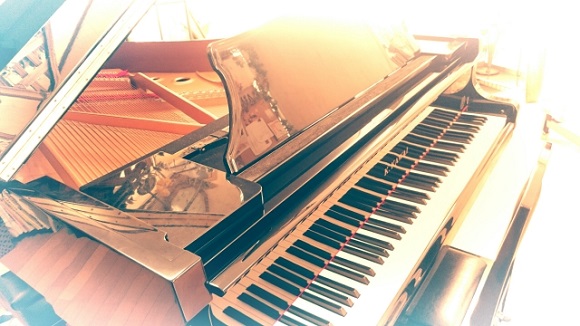
Chopin’s Waltz No. 9 Op. 69-1, also known as the “Farewell Waltz” or “Valse de l’adieu,” is a gem of a piece that enchants both the listener and the performer.
If you’re looking to expand your repertoire with a relaxed and romantic piece or want to play something elegant and sophisticated, this is a must-see.
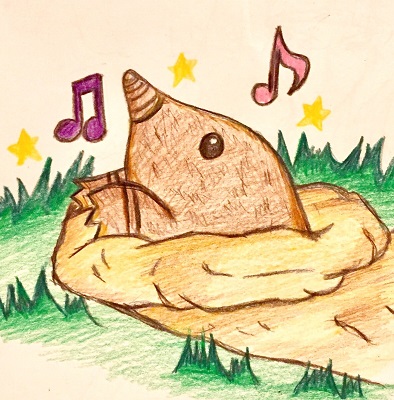
Hello! This is Mole, a piano enthusiast.
Autumn is well underway, isn’t it?
By the way, have you gone out to see the autumn foliage yet? Or perhaps you’ve already been?
Every year around this time, I dream of enjoying a breathtaking view of the fall colors from atop a tall mountain—just once in my life. But since I’m a mole, I end up giving up on the idea every year.
For several years now, I’ve been brainstorming ways to ascend to a mountaintop from underground.
Contents
The Difficulty Level Is Not Too High!

Now, let’s get to the main topic.
When it comes to the difficulty level of this piece, I’d say it’s relatively easy compared to other waltzes in Chopin’s collection. If you’re practicing Czerny’s “30 New Studies in Technique” (Op.849), this piece should be quite approachable.
That said, there are certain sections that require careful attention and a few slightly challenging parts in the score. Be sure to practice diligently without letting your guard down.
Expressive and Richly Varied Structure!
First, take a listen to the video below.As you’ll see when you glance at the sheet music, the structure of this piece is primarily composed of three expressive and distinct sections. In this article, I’ll discuss each section individually, roughly aligned with the key transitions in the score:
Section A (From the beginning to 1:00)
Section B (1:00 to 2:45)
Section C (2:45 to the end)
The times in parentheses correspond to the video. Watching the video carefully to get an overall sense of the flow and atmosphere of the piece beforehand will make your practice sessions much smoother.

☆A Lovely Love Story! A Column by Mole☆
Before delving into the explanation of how to play this piece, there is something I must talk about. That is the origin of the titles “Farewell Waltz” or “Adieu,” mentioned earlier, and the background behind the composition of this piece.This piece is said to be a work from Chopin’s younger days.
At that time, the young Chopin had a beloved woman in his life. That woman, Maria, was said to be the daughter of a German count. Their meeting reportedly took place when Chopin visited the home of a count he had known for a long time. (※1) How romantic!
It seems that Maria and Chopin were mutually in love, deeply drawn to each other.
However, for reasons that remain unclear (※2), their romance is said to have lasted only about one month. (※3)
In 1835, when Chopin bid farewell to Maria, he wrote and gifted this piece to her. According to one theory, the title “Farewell Waltz” was given by Maria herself. (※4)
To me, this piece is like a romance novel filled with the precious memories of their youthful days. It also feels as though their love story is woven into the music. If you imagine their story while reading the score, I believe you’ll discover many profound insights.
The story above was an episode that I summarized in an easy-to-understand way based on content written in reliable literature. However, there are other theories about the background of this piece that differ from the one mentioned above.
Below, I will touch on several notes mentioned in the text and discuss other prominent theories. It’s a long story, but I hope you’ll stay with me.
(※1)About how they met
According to various literature, it seems Chopin already knew Maria from her childhood. In other words, based on this theory, it wasn’t technically a “meeting” but a “reunion.”
(※2)Why they parted ways
There is a theory that Chopin and Maria were engaged, but later Maria’s parents opposed the engagement, leading to its annulment, which is said to be the decisive reason for their parting.
Incidentally, this piece is said to have been composed during their relationship in 1835, while the annulment took place in 1837.
(※3)The exact meaning of “one month”
The term “one month” is said to most likely refer not to “one month since their reunion” but rather to “the duration of their romance.”
Even after their passionate one-month romance ended, there is a theory that the two continued exchanging letters until the annulment in 1837. Evidence supporting this includes the discovery of a bundle of letters they exchanged.
(※4)Who named it?
There is also a theory that the title “Farewell Waltz” was not given by Maria but was instead coined by someone else long after her time.
Moreover, as you may notice upon listening to the piece, it conveys an atmosphere that seems more about “sweet love” than “farewell.”
As mentioned in (※2), this piece is said to have been composed in 1835, during Chopin’s relationship with Maria. Considering this, along with the theory mentioned in (※3) about their continued correspondence, it seems somewhat unlikely that Maria gave it the title “Farewell” as early as 1835.
Additionally, the meaning of the title is believed to be not about “the end of a sweet one-month romance in 1835,” but rather the sorrow of “their love being completely severed by the annulment in 1837.”
When viewed this way, the theory that someone else named it later seems more plausible.
Mole-Style Tips for Playing
☆How to Play Section A: Enjoy the Languid and Sweet Melody
Section A exudes a bittersweet and emotional atmosphere, with a hint of languor and wistfulness. Looking at the sheet music, you can interpret it in many ways, such as imagining “love as both romantic and fraught with troubles.” This flexibility is one of the delights of this piece. ※“Lento.” means “slow.”
※“Lento.” means “slow.”※“con espressione” means “with expression.”
If you listen to a recording of this piece, you’ll notice that it feels more like a ballad than a waltz. Traditionally, waltzes are designed for dancing, but with this piece, it’s hard to imagine feeling like dancing.
Pay special attention to the first beat of the left hand in this section. I must admit that even I sometimes overlook this detail, but the first beat of the left hand is written as a dotted half note. Since the time signature of this piece is 3/4, this means the sound must be sustained for three beats.
To put it more clearly, you press the key on the first beat and hold it while playing the second and third beats.
This is just my imagination, but if the first beat were a quarter note instead of a dotted half note, the atmosphere of the piece would probably feel quite different. However, as you can see, it is indeed a dotted half note.
By sustaining the first beat, the sense of languor, which is a defining characteristic of this piece, is brought out even more vividly. Therefore, take care to play the first beat of the left hand delicately and attentively.
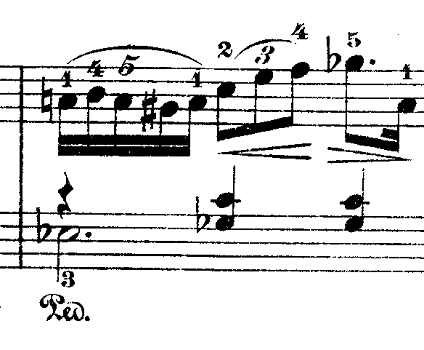
Here, the right hand introduces a phrase with a five-tuplet followed by a triplet. (0:20–)
I recommend not emphasizing this phrase too much. Treat it almost like a decorative note, allowing the subsequent G♭ to stand out more prominently.
Personally, I don’t think it’s necessary to play this tuplet section overly fast. However, playing it quickly can also be a valid interpretation, and some performers might find that playing it faster feels more natural.
This is a passage where individual interpretation can really shine, so I encourage you to try different approaches and find what works best for you.
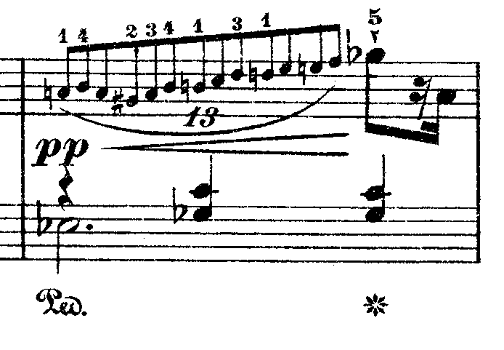
As for the thirteen-tuplet here, it can be considered a variation of the earlier five-tuplet and triplet phrase. You can approach the articulation of this section in the same way. (0:49–)
Play it subtly and delicately, avoiding excessive emphasis.
This section also includes pedal markings. However, pressing the pedal too deeply can make the sound muddy, detracting from the delicacy of the thirteen-tuplets. This could result in a somewhat blurred resonance.
I recommend pressing the pedal lightly in this section. In some cases, choosing not to use the pedal at all might also be a valid interpretation.
☆How to Play Section B: Passionate and Rhythmic
In Section B, the dynamics of the piece change significantly. (1:00–)This is because an entirely new phrase is introduced. Regarding Section B in particular, I highly recommend listening to various recordings thoroughly before starting your practice.
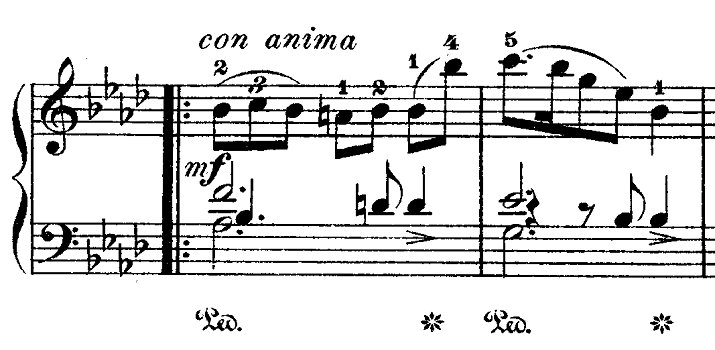 ※The meaning of “con anima” is “lively and fast.”
※The meaning of “con anima” is “lively and fast.”To be honest, this Section B remains a mystery to me. The score above still leaves me baffled. No, to be precise, it’s not the score itself but rather the actual way it’s played in recordings that puzzles me.
When I listen to various recordings, this section feels somewhat out of place compared to the rest of the piece.
Specifically, no matter how I listen to it, this part doesn’t sound like it’s in 3/4 time. I’ve considered that it might be one way to add expression or that the tempo might be shifting, but even then, it doesn’t quite sit right with me. This part genuinely remains a source of much contemplation for me.
“So, how should one play it in the end?”—My answer might sound extreme or irresponsible, but I suggest listening to various recordings and playing in a way that inspires you: “Oh, I like how this sounds!”
In other words, to put it bluntly, your first step is to imitate.
You might want to say, “Hey, Mole! That’s such a sloppy answer!”—I apologize. However, starting with imitation can eventually evolve into developing your own style or individuality, making the initial imitation meaningful.
When I first practiced this piece, I was very fond of a recording by pianist and conductor Vladimir Ashkenazy. While listening, I would often think, “So, this kind of expression is possible! I want to play like this!” and I listened to the recording countless times with admiration.
Spending time listening to your favorite performances and deepening your understanding of the piece is an immensely enjoyable experience. In this sense, imitation is undoubtedly a valid practice method.
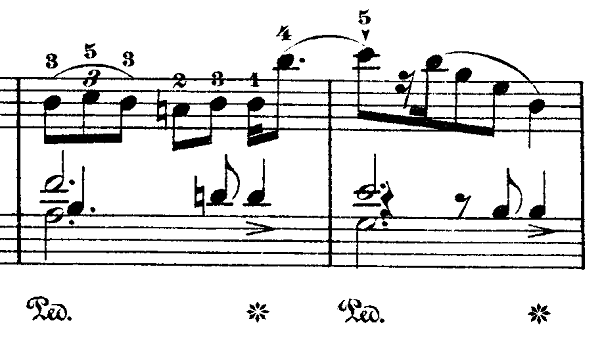
This section introduces slight variations compared to the previous phrase. (1:13–)
If you compare this score with the previous one, especially for the right hand, you’ll notice the addition of staccatissimo (meaning: to cut the notes even shorter than staccato) and sixteenth rests, creating an even more rhythmic and dynamic impression.
As for the left hand, the same applies to the previous phrase, but it’s crucial to sustain the sound of the first beat (the dotted half note chord) properly, just as in the left hand of Section A.
Additionally, the dotted quarter note near the dotted half note in the left hand is meant to be played simultaneously with the dotted half note chord. In other words, the first beat should produce a triad.
☆How to Play Section C: Further Development of the Scenes
Section C, once again, shows a different development compared to Section A and B. (2:45–)This is just my personal interpretation, but Section C gives me the impression of the romantic interplay between Chopin and Maria.
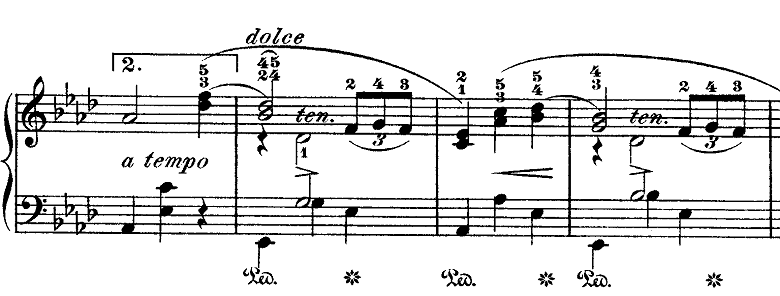 ※The meaning of “a tempo” is “return to the original tempo.”
※The meaning of “a tempo” is “return to the original tempo.”※The meaning of “dolce” is “gently.”
※“ten.” is short for “tenuto,” which means “to hold the note for its full value.”
Some of you might find this section of the sheet music a bit complicated. Personally, I often struggle with whether to play the D♭ on the second beat of the second measure with my left hand or my right hand.
For reference, I play this D♭ with my left hand. When you are unsure which hand to use, pay attention to the direction of the stems on the notes.
In my opinion, using the left hand here is more appropriate, but of course, if it feels easier to play with the right hand, that’s fine too. There’s no strict rule here, so feel free to choose whichever hand works best for you.
 ※The meaning of “poco a poco cresc.” is “gradually get louder.”
※The meaning of “poco a poco cresc.” is “gradually get louder.”As you can see from the sheet music, this section emphasizes the second beat throughout. You’ll also notice the accents. (3:05–)
This is a part where the intensity gradually builds. Although there are no specific instructions in the sheet music, I find that slightly increasing the tempo as the excitement rises adds more expressiveness to the performance.
Again, this is just my personal interpretation, but this section seems to express the romantic excitement or the quickening heartbeat between Chopin and Maria.
You can also feel a sense of freedom and exhilaration in this section. It’s a place where you can enjoy playing with a sense of playfulness and fun.
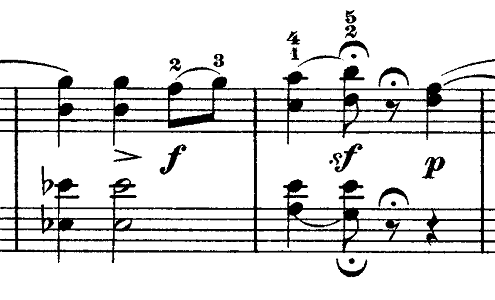
The previous phrase comes to a conclusion in this section. (3:11–)
Again, while there are no specific instructions, I think it could be interesting to intentionally slow down the tempo dramatically in the second measure of this section. However, musical expression is unique to each performer, so I think it’s best to try different approaches and find the one that feels most natural to you.
There is also a fermata (which means to extend the note or rest roughly twice its length), but I don’t think you need to stick rigidly to its definition. Just hold it for a length that feels satisfying to you.
Double-check! Overall Summary

Now, we’ve discussed Chopin’s Waltz No. 9 Op. 69-1. How did you find it?
Here, I’ve summarized the overall tips for playing this piece:
1. Be mindful of the transitions between sections and express them clearly (overall).
2. Pay attention to the note values in the left hand, and sustain the sound where necessary (especially in Section A and Section B).
3. Carefully consider how you use the pedal and adjust it appropriately (overall).
4. Play grace notes delicately and subtly, as if they were ornaments (overall).
5. It’s okay to start by imitating others (especially in Section B).
6. In addition to following the score’s instructions, value your own interpretation and expression (especially in Section C).
Keep these six tips in mind while practicing!
This piece is one of the most expressive works in Chopin’s collection of waltzes. As mentioned above, it’s not particularly difficult, and the changes between sections are quite clear. That’s why it’s especially recommended for those just starting to practice Chopin’s waltzes.
As noted, this piece allows for plenty of room for imagination.
So, once you’ve achieved a certain level of technical mastery, try focusing on conveying a message or a sense of storytelling through your performance, as if you were reading a book aloud to the audience.
Good luck with your practice! I’m cheering you on from underground in the fields every day.
- IMSLP (Score Link)
This article was created using this sheet music, published by Schirmer in 1894. It’s a public domain score and includes both pieces from Waltz Op. 69.
- Ranking Chopin’s Waltzes by Difficulty: A Piano Teacher’s Perspective 2017/3/17
- Perfect for a Piano Recital! Chopin's “Minute Waltz”: Difficulty and 3 Tips for Playing It 2017/5/25
- How to Master Chopin’s “Grande Valse Brillante”: Difficulty Level and Essential Waltz Techniques 2017/6/2
- Play with Fingerings That Suit You! Chopin’s “Grande Valse Brillante” Difficulty and Tips for Playing 2017/6/29
- How to Master Chopin's “Minute Waltz”: 8 Essential Tips and Difficulty Insights from a Mole 2017/7/6
- Master Chopin's “Waltz No. 7, Op. 64-2”: Tips, Tricks, and Difficulty Level Explained 2017/7/14
- Charming & Lyrical! Tips and Difficulty Level of Chopin's Waltz No. 14 in E Minor, Posthumous 2017/8/6
- Romantic Love! Chopin’s Waltz No. 9 Op. 69-1 Tips and Difficulty Level (“Farewell Waltz” or “Valse de l'adieu”) 2017/11/8 ←Currently Viewing Article
- The World of Brilliant Waltzes! How to Play and the Difficulty Level of Chopin’s “Grande Valse Brillante” 2017/12/6
- Chopin's Waltz No. 10, Op. 69-2: A Beginner’s Guide to Playing, Mastering, and Understanding Its Difficulty 2017/12/16
- Chopin’s Puppy Waltz Simplified: Easy Tips, Difficulty Level, and Playing Guide for Waltz No. 6 in D-flat Major, Op. 64-1 2018/3/9
- Chopin’s Waltz No. 15 in E Major: A Hidden Gem with Playing Tips and Difficulty Level Explained 2018/3/19
- Chopin’s Waltz No. 3 (Grande Valse Brillante) in A Minor, Op. 34-2: Difficulty and Playing Tips 2018/5/19
- Is Chopin’s “Minute Waltz” Hard? Learn 7 Tips to Conquer It Today 2019/8/1





















